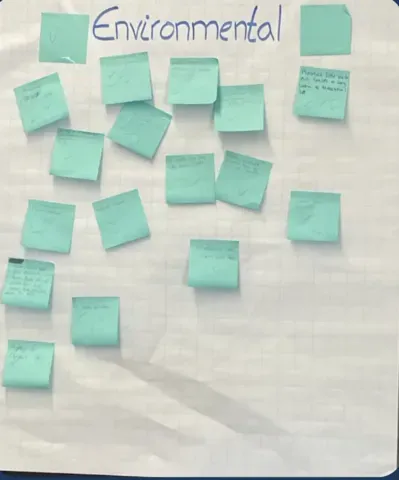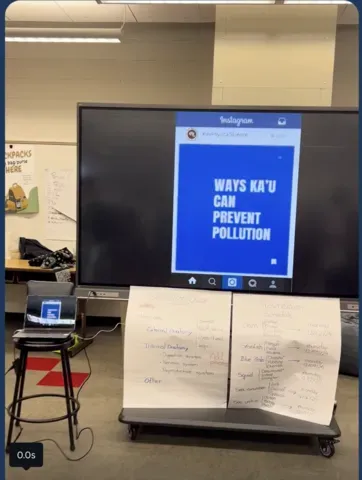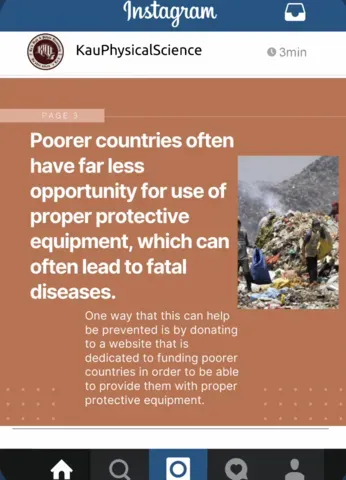This unit was created by Beatriz Ramos Jimenez, a high school english educator in Pahala, Hawaiʻi, as part of the 2024 Pulitzer Center Global Health Teacher Fellowship program. It is designed for facilitation across two days.
For more lessons created by Pulitzer Center Teacher Fellows in this cohort, click here.
This lesson’s value lies in fostering student agency and connecting their learning to community action. By culminating in a social media carousel and school-wide showcase, students can educate their peers and community about plastic pollution’s health and environmental impacts while proposing meaningful change. By engaging with relevant content, students grew in their awareness of environmental and social justice challenges and their role in creating solutions
Beatriz ramos jimenez, high school educator in Pahala, Hawaiʻi
Lesson Overview:
This lesson focuses on the global health and environmental crises caused by plastic pollution. It links its impacts on human health, ecosystems, and vulnerable communities worldwide to the students’ community of Kaʻū. Teachers should teach this lesson because it allows students to understand a pressing issue directly affecting their local and global environment. The lesson cultivates critical skills like problem-solving, empathy, and social responsibility, encouraging students to explore actionable solutions to reduce plastic pollution’s impact.
The pedagogical vision underlying this lesson emphasizes real-world connections and student empowerment. Through activities like brainstorming, gallery walks, and collaborative projects, students actively engage with global health themes, making learning meaningful and relevant. By understanding both the local and global stakes, students are inspired to take informed action and advocate for positive change within their community and beyond.
Essential Question
- “What can Kaʻū do to reduce the impact of plastic pollution on our community’s health and environment?”
Performance Task(s):
Students will work collaboratively (two people) to create a social media carousel in Canva to educate the Kaʻū community about the health impacts of plastic pollution, highlight research gaps, assess the limitations of existing alternatives, address social justice and environmental health findings, and propose actionable solutions to reduce plastic pollution locally.
Students can create this carousel using information from previous articles and the study “The Minderoo-Monaco Commission on Plastics and Human Health” from Boston College.
The carousel will have at least four pictures, including at least four of the following:
- Background information about plastics.
- Health impacts of plastic pollution.
- Research Gaps.
- Limitations of existing alternatives.
- Social Justice
- Environmental Health Findings.
- Call to action.
Topics 2 and 7 are non-negotiables. Students will pick two more to create a carousel with four photos. They can use ideas from the previous activity.
Option: Create a presentation for a school-wide showcase, so that visitors can explore the different carousels.
Assessment:
Students reflect on their learning experience and discuss what they discovered about the health impacts of plastic, the importance of research, and how they can contribute to positive change in Kaʻū. The assessment will happen during the class discussions, and their product will be the social media carousel created in Canva.
Notes on Context:
My students ' reading levels in my class vary from 2nd to 12th grade, so some students may find the articles challenging. I implement strategies like reading aloud, using graphic organizers, jigsaw activities, or pairing students to support understanding. The lesson is designed to guide students in thinking about connections to their community in Kaʻū, Hawaii, but the lesson questions can be adapted to reflect any location.
This lesson was designed for a ninth grade physical science class. Facilitation is suggested across two days. This lesson plan includes pacing, texts and multimedia resources, teacher-created resources, and suggestions for implementation.
| Focus Pulitzer Center news story/stories | “There’s Almost No Research on the Health Impact of Plastic Chemicals in the Global South” by Aryn Baker for TIME “Trash Sorters in The Minderoo-Monaco Commission on Plastics Human HealthGhana Face Health and Safety Risks” by Ridwan Karim Dini-Osman for The World |
| Teacher-created resources | The Minderoo-Monaco Commission on Plastics from Boston College [Template] Interview: Plastics and Global Health [.pdf][.docx] |
Next Generation Science Standards
HS-PS1-3: Plan and conduct an investigation to gather evidence to compare the structure of substances at the bulk scale to infer the strength of electrical forces between particles.
Students will investigate the structure and properties of conventional and alternative plastics, exploring why certain materials degrade differently. This standard can be addressed through discussions on why plastics and bioplastics don't readily break down and the role of chemical additives in durability.
HS-ETS1-1: Analyze a major global challenge to specify qualitative and quantitative criteria and constraints for solutions that account for societal needs and wants.
In the lesson, students analyze the environmental and health impacts of plastic pollution from the Pacific Garbage Patch and the shortcomings of alternative plastics, identifying criteria for effective solutions. They then propose community-based interventions, considering constraints like local infrastructure and funding.
HS-ESS3-4: Evaluate or refine a technological solution that reduces impacts of human activities on natural systems."
Students assess alternative plastics, evaluate potential solutions and limitations of biodegradable materials, and brainstorm new ideas to mitigate plastic pollution in their local environment.
The following are examples high school science students in Pahala, Hawaiʻi who engaged with this lesson in fall 2024.
1. Students start the lesson be brainstorming types of plastic pollution that they see in their communities. They then engage with an interactive activity where they use post-its to brainstorm the impacts of plastic pollution on human health, environmental health, and community livelihoods

2. Next, students engage with two Center-supported articles on the impact of plastic pollution on community health and use guiding questions to analyze the articles. They then use an interview template [.pdf][.docx] to conduct interviews with a classmate about connections between the articles and issues in their local communities.
I learned about global health and plastic pollution and how bad it can be for our native species. One thing I'm still thinking about after the lesson is what would happen if we didn't take care of our global health and plastic pollution.
Tia, a student from Kau High and Pahala Elementary Schoo
3. Finally, students use their analysis throughout the lesson to create a social media carousel in Canva to educate the Kaʻū community about the health impacts of plastic pollution, highlight research gaps, assess the limitations of existing alternatives, address social justice and environmental health findings, and propose actionable solutions to reduce plastic pollution locally.


Teacher Reflection:
The lesson Plastics, Bioplastics, and Health was designed to address a pressing issue directly impacting our students and their community in Kaʻū: plastic pollution and its associated health and environmental consequences. This lesson’s value lies in fostering student agency and connecting their learning to community action. By culminating in a social media carousel and schoolwide showcase, students can educate their peers and community about plastic pollution’s health and environmental impacts while proposing meaningful change.
Beatriz ramos jimenez, high school educator in Pahala, Hawaiʻi
What is the focus of your lesson plan, and why did you write this lesson for your community?
The lesson Plastics, Bioplastics, and Health was designed to address a pressing issue directly impacting our students and their community in Kaʻū: plastic pollution and its associated health and environmental consequences. In this two-day lesson, students explore the local and global health impacts of plastic chemicals, assess the limitations of bioplastics, and propose actionable solutions to reduce plastic waste in their community. By focusing on real-world applications and the specific challenges of Kaʻū, the lesson empowers students to connect global issues with local experiences.
The lesson integrates multiple standards, guiding students to analyze scientific and societal aspects of plastic pollution while developing critical thinking and collaborative problem-solving skills. Using Pulitzer Center articles, students understand how plastics disproportionately impact vulnerable populations, especially in the Global South, and the research gaps that hinder effective solutions. They also evaluate the role of waste pickers and explore sustainable strategies to address these challenges.
This lesson’s value lies in fostering student agency and connecting their learning to community action. By culminating in a social media carousel and schoolwide showcase, students can educate their peers and community about plastic pollution’s health and environmental impacts while proposing meaningful change. This approach emphasizes relevance, advocacy, and the importance of student voice in addressing global and local challenges.
How did you build this lesson with your community in mind?
Kaʻū High & Pahala Elementary School is a small, rural K-12 school located in Pahala, Hawaiʻi, at the heart of the largest district in the state, spanning over 600,000 acres. With a rich history from 1881, our school serves 490 students from diverse cultural and linguistic backgrounds. Many of our students come from economically disadvantaged households—89% of families qualify as such, and all students receive free breakfast and lunch. Additionally, 19% of our students are English learners, representing a variety of languages and cultures.
Traditional practices like hunting and fishing are popular hobbies in our community, reflecting our students’ connection to the land and ocean. These interests influence how we approach teaching and learning, grounding our lessons in real-world applications and community relevance.
When designing my lessons, I strive to connect academic concepts to students’ lived experiences and cultural practices, ensuring they are accessible and engaging for all learners. I prioritize scaffolding for English learners and fostering collaboration to leverage our students’ diverse strengths. Understanding our unique school and community context helps highlight the importance of teaching in ways that honor and empower our students while addressing their diverse needs.
What did your students learn while engaging with this lesson?
While engaging with the lesson Plastics, Bioplastics, and Health, students expanded their understanding of the health impacts of plastic pollution and the challenges of finding sustainable alternatives. They analyzed scientific articles, connected global issues to their local context in Kaʻū, and brainstormed actionable solutions for their community.
One striking moment came during the discussion of the Pulitzer Center article about waste pickers in Ghana. Many students were surprised to learn that waste pickers existed and were shocked by the risks they faced. One student commented, “I didn’t know people actually had to pick through trash to survive.” Another noted, “They don’t even have safety equipment, so no wonder they get sick.” These realizations deepened their understanding of how plastic pollution disproportionately affects marginalized communities and highlighted the issue’s global nature.
Students demonstrated their learning through gallery walks and the creation of social media carousels. One group focused on the lack of protective measures for waste pickers in Ghana and compared the struggles with managing plastic waste in Hawaii. They proposed community-led solutions like beach cleanups and workshops on making bioplastics from local materials.
This lesson helped students connect global and local issues, encouraged critical thinking, and empowered them to take action. By engaging with relevant content, students grew in their awareness of environmental and social justice challenges and their role in creating solutions.
What were your takeaways from this experience, and what advice do you have for other educators who may want to engage with your lesson?
Creating and teaching the lesson Plastics, Bioplastics, and Health was an enriching experience highlighting the value of connecting global challenges to students’ local context. Students became deeply engaged as they explored the impacts of plastic pollution in both their community and the wider world, empowering them to think critically about sustainable solutions they could implement in Kaʻū.
One key takeaway was the importance of having clear and accessible instructions and examples displayed throughout the lesson, which proved invaluable, especially for English learners and students who benefit from visual references. Keeping the instructions visible at all times allowed students to stay focused, independently clarify steps, and participate more confidently in activities like gallery walks and collaborative brainstorming. Equally important was the value of scaffolding and differentiation. With reading levels ranging from 2nd to 12th grade, adjusting articles and providing support through strategies such as reading aloud, using graphic organizers, and facilitating group discussions ensured all students could access the content. This lesson underscored the importance of meeting students where they are and creating an inclusive, supportive space for learning.
For educators planning to use this lesson, I recommend emphasizing local examples of plastic pollution to make the content more relevant and relatable for students. Incorporating interactive strategies such as gallery walks, color-coded sticky notes, and small group discussions fosters collaboration and creativity. Additionally, adapting reading materials to meet the diverse needs of your students ensures inclusivity and accessibility.
This lesson reinforced the value of providing students with tools and opportunities to connect their learning to real-world issues. By making the content relevant, collaborative, and clear, students were inspired to think critically and take ownership of their role in creating change.
As part of the fall 2024 fellowship, “Making Local Connections to Global Health Stories,” 14 educators from nine states created and taught lessons to engage their over 1,500 students in making local connections to global health news stories. Click here to learn more about the fellows and their collective impact.










